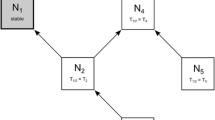Abstract
Bioassays are applied to workers and other people exposed to radiation through routine or accidental intake of radioactive isotopes. The quantity of the isotope intake by an individual can be estimated from the measured quantities in the bioassays using the corresponding retention or excretion function. A retention (excretion) function represents the predicted activity of a radionuclide in the body, organ, or tissue or in a 24-h excreta at a particular time after the intake. The International Commission on Radiological Protection provides these biokinetic models. We have used these functions to compute optimal experimental designs for estimating the intake quantity in workers following radionuclide inhalation or ingestion. In particular, we have considered the case where the individual is exposed to a constant intake during some periods followed by other periods without intakes, which we called multiple constant intakes. The main aim of this work is finding the best times where the bioassay samples should be obtained in order to estimate optimally the actual intake of the last period. The problem is also extended to compute the next two or more bioassays to be performed. Measurements on the same worker are modeled through a correlation structure. The outline of the problem is established for a general case and results are given for a typical case as a real example. The methodology given in the paper can be applied to other cases with multiple constant intakes, e.g. in medical treatments where the patient is exposed to successive doses during particular periods.





Similar content being viewed by others
References
Amo-Salas M, López-Fidalgo J, Rodríguez-Díaz J (2010) Optimizing the test power for a radiation retention model. Pharm Stat 9:55–66
Amo-Salas M, López-Fidalgo J, Porcu E (2013) Optimal designs for some stochastic processes whose covariance is a function of the mean. Test 22(1):159–181
Atkinson AC, Donev A, Tobias R (2007) Optimum experimental designs, with SAS. Oxford University Press, Oxford
Bechler A, Romary T, Jeannee N, Desnoyers Y (2013) Geostatistical sampling optimization of contaminated facilities. Stoch Environ Res Risk Assess 27:1967–1974
Campos-Barreiro S, Lopez-Fidalgo J (2015) D-optimal experimental designs for a growth model applied to a Holstein-Friesian dairy farm. Stat Methods Appl 24(3):491–505
Elfving G (1952) Optimum allocation in linear regression theory. Ann Math Stat 23:255–262
Fedorov VV, Hackl P (1997) Model-oriented design of experiments. Lecture notes in statistics. Springer, New York
ICRP (1994) Human respiratory tract model for radiological protection. ICRP Publication 66. Ann ICRP 24(1–3)
ICRP (1997) Individual monitoring for internal exposure of workers (preface and glossary missing). ICRP Publication 78. Ann ICRP 27(3–4)
ICRP (2006) Human alimentary tract model for radiological protection. ICRP Publication 100. Ann ICRP 36(1–2)
ICRP (2015) Occupational intakes of radionuclides: part 1. ICRP Publication 130. Ann ICRP 44(2)
ICRP (2016) Occupational intakes of radionuclides: part 2. ICRP Publication 134. Ann ICRP 45(3/4):1–352
ICRP (2017) Occupational intakes of radionuclides: part 3. ICRP Publication 137. Ann ICRP 46(3/4)
Jacquez J (1996) Compartmental analysis in biology and medicine. BioMedware, Ann Arbor, MI
López-Fidalgo J, Sánchez G (2005) Mathematical statistical criteria to predict internal doses. Health Phys 89(4):333–338
López-Fidalgo J, Villarroel J (2007) Optimal designs for models of radiation retention with poisson correlated response. Stat Med 26(9):1999–2016
López-Fidalgo J, Rodríguez-Díaz JM, Sánchez G, Santos-Martín M (2005) Optimal designs for compartmental models with correlated observations. J Appl Stat 32(10):1075–1088
Pázman A (1986) Foundations of optimum experimental design. D. Reidel publishing company, Dordrecht
Pázman A (2004) Correlated optimum design with a parametrized covariance function. Technical report, Deptartment of Statistics and Mathematics, Wirtschaftsuniversität, Vienna
Pázman A (2007) Criteria for optimal design of small-sample experiments with correlated observations. Kybernetika 43(4):453–462
Rodríguez-Díaz JM, Santos-Martin T, Waldl H, Stehlik M (2012) Filling and d-optimal designs for the correlated generalized exponential models. Chemom Intell Lab Syst 114:10–18
Sánchez G (2007) Fitting bioassay data and performing uncertainty analysis with biokmod. Health Phys 2(1):64–72
Sánchez G, López-Fidalgo J (2003) Mathematical techniques for solving analytically large compartmental systems. Health Phys 85(2):184–193
Sánchez G, Rodríguez-Díaz J (2007) Optimal design and mathematical model applied to establish bioassay programs. Radiat Prot Dosim 1–7. https://doi.org/10.1093/rpd/ncl499
Stehlík M, Rodríguez-Díaz J, Müller W, López-Fidalgo J (2008) Optimal allocation of bioassays in the case of parametrized covariance functions: an application to lung’s retention of radioactive particles. Test 17(1):56–68
Stehlík M, Casero-Alonso V, López-Fidalgo J, Bukina E (2015) Robust integral compounding criteria for trend and correlation structures. Stoch Environ Res Risk Assess 29:379–395
Acknowledgements
The authors have been sponsored by Spanish Research Agency and fondos FEDER MTM2016-80539-C2-R1 and MTM2016-80539-C2-R2 respectively and both of them by Consejera de Educacin, Cultura y Deportes of Junta de Castilla y Len SA080P17. The first author was also sponsored by Consejera de Educacin, Cultura y Deportes of Junta de Comunidades de Castilla-La Mancha and Fondo Europeo de Desarrollo Regional SBPLY/17/180501/000380.
Author information
Authors and Affiliations
Corresponding author
Additional information
Publisher's Note
Springer Nature remains neutral with regard to jurisdictional claims in published maps and institutional affiliations.
Rights and permissions
About this article
Cite this article
López-Fidalgo, J., Sánchez, J.G. Optimal bioassay time allocations for multiple accidental chronic intakes of radioactive particles. Stoch Environ Res Risk Assess 33, 905–914 (2019). https://doi.org/10.1007/s00477-019-01668-0
Published:
Issue Date:
DOI: https://doi.org/10.1007/s00477-019-01668-0
Keywords
- Bioassays
- Biokinetic models
- c-optimality
- Covariance structure
- Design efficiencies
- Radioactivity retention



